Text and photos: Akul Tripathi
Perhaps what differentiates us as a species from any of the other millions of organisms on the planet is our need to tell stories of our achievements, of our times, of the world as we knew it.
Over time, new stories were added as some dulled in memory. Stories and storytellers waged wars with intent to create new tales, to rewrite and erase old ones. To stamp their tales over their ancestors’. From the oldest to the newest, these have always existed in our universe. In reverberations, in faded dye on decomposing tree skins and in weathered stone. They introduce themselves as insistent memories of inexplicable founts, of unconscious readings in abstract brush strokes and markings in stone that their unassuming targets chance upon.

It is one such series of stories set in stone that trailed my way as I wandered through what we today know as Karnataka. In another millennium, about 1500 years ago, it was the part of peninsular India to which the movers and shakers of the time gravitated. A region riddled with rocks and set between the rivers Krishna and Narmada, became a stage for an enactment of stories that is posthumously called the saga of the making of the cradle of Indian architecture. The initiated will see the nuances of temple styles and construction techniques and other such jargon. Others, like me, will see stories. Stories of places that got made by people who had their own stories. Bustling capitals then and wormholes of history now – Aihole, Badami and Pattadakal. A story that entrusted itself to me. A duty of retellings that I must fulfil.
A story begins…
A long, long time ago, at a place on the banks of the River Malaprabha, which strolls to meet the River Krishna, lived two demon siblings named Vatapi and Ilava. Ilava had a boon that whosoever he calls out to will come to him, even from beyond the horizon of death. Together, they would use this boon to rob passersby and especially mendicants in a particularly gruesome way. Ilava would turn Vatapi into a ram and then kill it and cook its meat and offer it to the travellers they would chance upon. Once the unsuspecting traveller had eaten the meat, Ilava would bring into play his boon. He would call out to Vatapi and Vatapi would emerge from the innards of the traveller, killing him. The duo would then make away with his possessions.
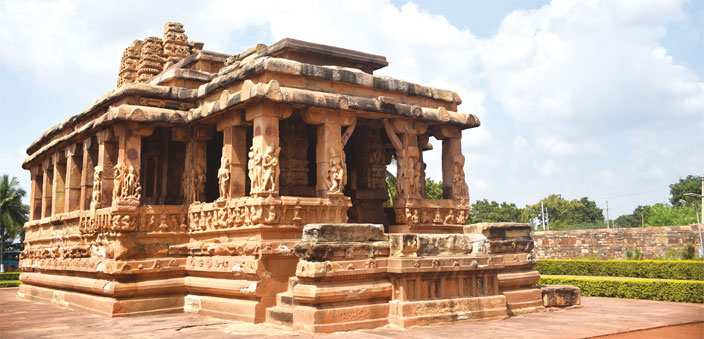
For many years they kept at this heinous crime they had perfected. Then, whether it was by the pleas of people or by some divine sense of cosmic balance, no one can say for sure, there arrived in the Malaprabha Valley, the venerable sage Agastya. Unaware of the divine powers that fed the humble appearance of the sage, they played the practiced ruse on him. In the way they had hundreds of times before, Ilava fed the meat and then called out to Vatapi.
However, nothing happened! Illava stared dumbfounded at Sage Agastya who was half smiling in contentment. He had known or divined the intentions and the boon of Ilava, and had digested the meat of the ram that was Vatapi as soon as the food had hit his stomach, killing him in a manner from which there was no coming back. Thus, sage Agastya rid the people of Malaprabha Valley of the demonic brothers and peace reigned thereafter. In memory of what evil was capable of, two peaks near the place that Agastya triumphed were named after them.
An unaccountable number of years later, in what we know to be the middle of the 5th-6th century, emerged in this same Malaprabha Valley the dynasty known as the Early Chalukyas, or as they would be known by the colour of the red sandstone cliffs and rocks on which they wrote their story – the Badami (almond coloured) Chalukyas. The story of the Chalukyas is an important milestone in the history of South India and is considered to be the golden age of Karnataka. Over a period of roughly 600 years, the Chalukyas ruled as three related but individual dynasties – the Eastern Chalukyas, the Western Chalukyas and the Badami Chalukyas. Of the three, it is the Badamis who held sway over the Malaprabha River Valley and it is them who authored this tale that caught me and through me, you.
The present city of Badami in northern Karnataka, regarded by many as the site where Agastya slew Vatapi, became their capital. Their kingdom at its zenith occupied almost all of Maharashtra, Goa and Karnataka, and spilled over into parts of Andhra Pradesh, Telangana, Tamil Nadu, Kerala, Madhya Pradesh and Gujarat in today’s political geography. As vast as their kingdom was in its heyday and its subsequent splitting into various power centres, the Malaprabha Valley in the Golden Era of the dynasty became the melting pot of northern and southern ideas. What the Sangam period is to the literature of the country, the prosperity of the Chalukyas brought to architecture.
Much before Badami bore the title of the seat of Chalukya power, the status was bequeathed to a small, sleepy village also on the banks of the Malaprabha, an hours drive from Badami – Aihole. A separate series of stories remembers this place as where Vishnu’s avataar washed his axe after the slaying of the kshatriyas. It is regarded by some as the place which in 450 CE, was the capital in the early days of the Chalukyas. And it is from where we must begin this tale.

From a time in the indiscernible past, Aihole was an agraharam – a village with a spatial arrangement of town planning such that roads would run north south with houses on either side, leading up to the temple of the village God in the centre, thus resembling a garland (haar) around the temple. Traditionally, at one end of the road would be a temple to Shiva and at the other end, one to Vishnu. The garland remains, but a vestige to the current Aihole which resembles more a pendant in itself, glittering with temples, held together by strings of settlements.
Through times leading up to the 12th century, Aihole served as a receptacle to ground breaking experiments in temple making with the golden sandstone rocks – some built right into the cliffs. One hundrend and twenty five of these story pods have evaded centuries of time and the perils that come with time to reach us with their story. The story of how stones and stories of the North and the South fused, of how this valley, 8 km at its widest, began a genesis of temple architecture in India.
The monuments in Aihole can be divided into two major periods of making – of the Early Chalukyas in the 5th-6th century and that of the late Chalukyas in the 11th-12th century. Remnants of stone walls are visible in various parts of the village and are dated to the period of the Late Chalukyas and scholars opine that the stone walls replaced what were once earthen ramparts. Perhaps Chalukyan Aihole would have been contained by the fortifications in an approximate 500 metres ring. Today, the temples are everywhere, without any apparent grouping. But for some semblance of order, they could be said to be in four primary locations – on the nearby Meguti Hill, the Durga Temple Complex, within the main town and the Siddankola site, a short distance from the town.
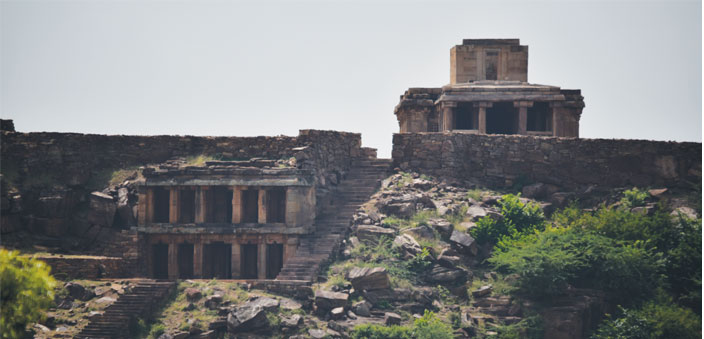
The Meguti Hill and the Durga Complex
The Meguti Hill is a towering feature in the landscape of Aihole. One that can be seen from almost any point within the town. A flight of steps leads up to the top of the hill which is a flat terraced feature. Just before the crest is a Buddhist temple, and on the very top is a Jain temple. Based on an inscription found here, the temple can be dated to 634 CE. The temple stands in the middle of a large enclosure with piles of rubble scattered around. The presence of these temples, besides pointing to just a secular disposition of the Chalukyas, draws attention to the prominence of these religions in the region based on the prominent placement of the places of worship. Also carved into the southern flank of the Meguti Hill is a Jain cave temple which may be one of the earliest with indications of having been carved as early as the latter half of the 6th century.
Of further interest historically, though not a distinction of the Chalukyan story, is the presence of some dolmens, many of which now lie collapsed. Dolmens are mysterious structures which tell a story, yet indecipherable, of times far older. Found in various shapes, sizes and complexities the world over, the oldest dolmens in Europe are dated to over 7000 BCE. While some attribute them to be a kind of single chamber megalithic tomb, others associate them with various other beliefs and metaphysical uses and practices. In essence, they are four upright slabs of stone covered with another larger piece of stone, depicting a rudimentary room. The ones on Meguti Hill are dated to the 1st–2nd millennium BCE.
Not too far from the hill, on ground level is the principal attraction of Aihole – the Durga Temple Complex. The throng of visitors to it is quite natural, as amongst the group of temples in Aihole, it is by far the largest and the most richly embellished Hindu temple. However, the name is quite a misnomer as it is not a Durga Temple! It is in fact, a temple dedicated to the Sun God which was constructed in the 8th century. The name stems from tthe stone rubble look-out (or durg, now removed) that was erected on top of the temple, possibly as a fortified lookout, part of a much larger fortification, probably of the Marathas. This temple, with a semi-circular end is one of the state’s iconic picture postcards.
This apsidal-ended layout is traced back to the rock-cut Buddhist Chaitya halls from the 2nd and 1st century BCE, but is unique in the context of early Chalukyan architecture. The entrance to the complex is from the west, giving a full view of this semi-circular ended sanctuary. Like all Sun temples, the temple itself is aligned on the east-west axis with the entrance to the sanctuary from the eastern side. An entrance porch, the rectangular mandapa and the inner sanctuary complete the temple. Rising from the roof is an incomplete Nagar styled tower, with its crowning amlaka filial tower having fallen off.
The circumambulatory route along with the porch is home to exquisitely carved reliefs and sculpted columns. The walls have regularly spaced niches alternating with perforated windows. The niches are headed with pediments displaying diverse Dravida and Nagara elements which are masterpieces of art. The ceilings are alive with medallions that are as unique to the temple as they have similarities across the temples in the Malaprabha Valley, especially the Badami caves. Compared to the verandah and the entrance porch, the mandapa interior is quite plain. Similarly, the columns are carved and decorated towards the eastern entrance as compared to those on the westward side. Perhaps, the temple was never as finished as it was intended to be?
Within the premises of the Durga Sun Temple complex are also other monuments and temples, including the open air archaeological museum. The lawns, especially in front of the museum are dotted with several pieces of stones, memorials and what were once parts of temples. Another temple that arouses interest especially because of its name is the Lad Khan temple.
No one is quite sure how the name of the temple retains the name of a Muslim inhabitant in former times. That remains a story lost to time. The temple, however, stands fairly intact and is amongst the few I have chanced upon which has a terrace that was once accessible through a stone ladder. The joints that hold up the roof are protected by log-like stone strips which are reminiscent of timber architecture. The walls are carved as large perforated screens with geometric design that allow light inside the temples. The figures inside, especially the one of a woman with a horse’s head, are considered a highpoint of early Chalukyan art.

Also in the premises are the Suryanarayana Temple, the Gaudargudi Temple, a large water tank, an exceptionally preserved Nagara-styled tower of the Chakragudi Temple, and the Badirgargudi Temple. The entire town outside the complex is similarly bejewelled with temples and shrines any way one turns. In the absence of houses, it would make the entire area seem like one large workshop for artisans focussed on creating a place of worship to each one of the 33 crore Gods of the pantheon, and then the Buddhist and Jain Gods as well! It is a sight that needs to be seen to be believed.
A short walk from the town to the base of one of the mountains is one of the oldest rock cut temples in the area – Ravanaphadi. As infrequent it is to chance upon Hindu cave temples, even amongst the ones that one does chance upon, like the ones in Badami, Ravanphadi is in a league of its own. It is a Shiva temple that is bigger than any of the cave temples that we will visit at Badami.
The temple has a large open space in front of it and the ritual Nandi facing the shrine inside. A set of steep steps leads to the entrance of the cave which consists of ornately carved stone columns and on either side of the entrance are rectangular hallways with pillars providing a sense of space and calm before one reaches the stillness of the sanctum sanctorum.
The inside is definitely a calm space, not like being underground which seems like a different world, but as if the mountain becomes a shield between the self and the world outside and in that secret little niche will one meet an experience of the otherworldly. The otherworldly, more than that of a spiritual sense is one of sheer wonder at what times must they have been when people spent significant portions of their lives, carving their Gods out of the stone walls that held them.
The walls are richly adorned with intricately carved statues of detail that seems otherworldly (there goes that word again) when imagined in the age that they must have been carved. There are reliefs of Shiva in the avataar of Ardh-nareshwara,Hari-hara(amalgamation of Vishnu and Shiva); of Durga slaying Mahisha, Varaha rescuing Bhudevi, of Shiva and Parvati on Nandi, and Vishu and Lakshmi on Garuda. The grandest of it – my memory of Aihole along with the apsidal Surya temple – is the tableau dominated by a ten-arm Shiva photo-sculpted in that picture perfect moment of dance ecstasy. As the light dims while one stares fixedly at the almost believable impressions scratched out of stone by the vision and skills of a master artist; it must be just delusion, but there was a rhythmic thumping that matched that of my charged heart and just for that instant, there was no stone…there was no mountain…and there was no me…
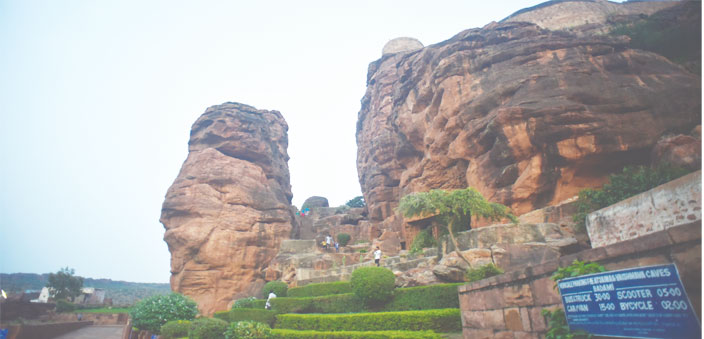
The story of the beginnings of the Chalukyas has many variations. Some believe that the earliest known ruler is Jayasimha Vallabha (approximately 500-520 CE) and his son Ranaranga (approx 520-540 CE), who were chiefs under the Kadambas who ruled most of present-day Karnataka. At the decline of the Kadambas, the Chalukyas came to power. However, many believe the line to be established and officially begun when Ranaranga’s son Pulakeshin I (543-566 CE) came to power and shifted the capital symbolically from the place they were earlier chiefs – Aihole to Badami – or what was then Vatapi. The move was also a strategic one for the infant kingdom as the place was flanked by high mountains on three sides, making it a sure stronghold which was further strengthened by his construction of fortifications on top of the hill. However, what concerns us is that in the shade of that safety blossomed four caves that tell a story more enthralling than the mundane wars, mysteries and intrigues of kingdoms.
The regal emblem adopted by Pulakeshin I was that of the Varaha or boar avataar of Vishnu. However, the kings were not worshippers of only one God or sect of Hinduism. Shiva, Surya and Vishnu all received veneration along with deities of Buddhism and Jainism.
On approach, the first cave is dedicated to Shiva, as is apparent immediately with an 18-armed figure of Shiva carved at the entrance. The nine arms on each side have a specific hand gesture, which locals proudly say in combinations represents each of the 81 gestures of Bharatanatyam. More inscriptions from the Shaivite cannons are present with sculptures of Harihara in the company of Parvati and Lakshmi and Ardhanareshwara with the skeletal Bhringi and Nandi on the Shiva male side and a female attendant carrying a jewel case on the female side. For the most exquisite work though, one must quite symbolically look up to the cave ceiling which is adorned with some outstanding workmanship, especially the coiled serpent Nagraja who looks ready to drop off from the ceiling.

The second and third caves, accessed through ascending an exterior flight of steps are dedicated to Vishnu. The second cave is considered to be made at a later date than the third cave and is regarded by those in the know to be an inferior copy of cave number three. The largest relief in cave number two shows Vishnu as Trivikarma – His vamanaavataar with one foot on Earth and another directed north. Several other representations of Vishnu in His various incarnations and legends from the Bhagavata Purana adorn the walls of this usually run-through cave.
The third cave seems a continuation of imagery from the second cave except with much more zing in it. It is the most intricately carved cave at Badami and continues the exploration of the various forms of Vishnu including one depicting Him as Harihara. Vishnu is represented in his ashtabhuja avataar- having eight arms and also as Vaikuntha, seated on the coils of shesha. Ceilings, as is the case in Badami inspire awe yet again with a particularly uncommon depiction of Indra on his elephant, in the company of dancers and musicians. The star attraction of the Badami caves is perhaps in this cave with murals on the ceiling, which are considered amongst the earliest known surviving evidence of fresco painting in Indian art.
The last cave is situated at a higher level than the other caves and has its own little terrace. It is dedicated to the revered figures of Jainism and is the newest of the caves of Badami dated from the 7th-8th century to the later Chalukya period of 11th-12th century. It depicts the saint Bahubali with vines wrapped around his legs and Parshvanatha with a multi-headed cobra rising over his head among others. Many Jain tirthankara images have been engraved on the inner pillars and walls along with carvings of yakshas, yakshis and other tirthankaras.
However, the story of the Badami caves has more intrigue than is immediately discernible. Between caves 2 and 3 is another natural cave which has even the experts stumped in deciphering its story. Some believe it to be a Buddhist cave with a carving of Padmapani holding out a lotus, and a devotee seated near the Boddhisattva. Another opinion recognises it as a depiction of Buddhavtara Vishnu, while some recognise it as a Jain figure. And for another twist, in 2013, the Government of Karnataka reported the discovery of another cave at a short distance from these four which reportedly has 27 carvings. As much as Badami appears a showcase, it has hidden in its folds still many secrets.
Opposite the caves, in sort of a natural gulf, is a water tank that is named the Agastya Lake in honour of his ridding the residents of ancient Vatapi of the demon bothers. On the cliff tops surrounding the lake are remnants of several fortifications including some built by Tipu Sultan when he occupied Badami for a brief period. Also built along the banks of the tank and on the flat hill tops are other temples and shrines to a wide array of deities. The erstwhile palace of the king has been converted into an archaeological museum and the transition from the current city to the stone environs of the past, with life continuing seamlessly through a lone surviving doorway is representative of the real India. Where history and the present blend into each other seamlessly and, perhaps the reason it is not glorified and handled with pampered hands, is because the people don’t see it as somebody else’s who owned it a long, long time ago. It is their very own and if it is lost and or broken? “Well, we’ll make a new one and people a thousand years later can break it”, they say with a customary shrug of the shoulders.
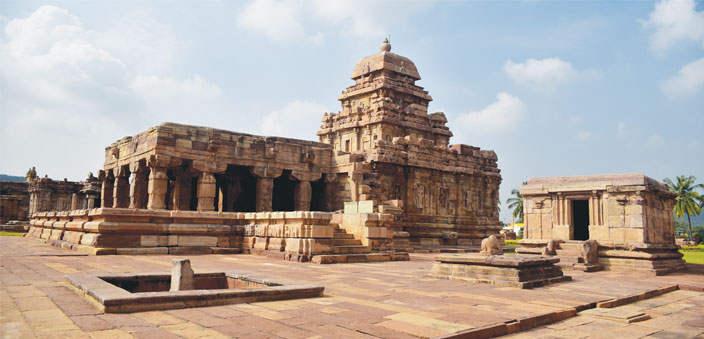
As per the most ancient of sources, the Himalayas to the north of the country are the most sacred of mountains, the direction north is also auspicious and the rivers that flow from the Himalayas are holy. The Ganga being the holiest of holies and especially more so when she is is uttaravahini or northward flowing. It is to the left bank of the stretch where the Ganga flows to the North that the eternal city of Kashi was established. Similarly, any northward stretch of a major river is considered auspicious and settlement is based on the left bank, built to catch the first rays of the sun over the holy river. Such it is even with the Malaprabha at a particular point where the river turns north and on its left bank is the small village of Pattadakal with a group of monuments that are now a World Heritage Site (WHO), testifying to older times when the auspicious stretch was the place of coronation of the Chalukyan kings.
The ancient temple town of Pattadakal illustrates the apogee of temple making of the Chalukyan style, which originated in Aihole and through experimentation was perfected between Aihole and Badami. Built in the 7th century, it is a marvellous blend of architectural forms of the North and South India. On the bank of the softly flowing river, there are a series of Hindu temples dedicated to Shiva and a Jain temple. It is at this auspicious site that the Chalukyan kings were crowned.
Theses temples represent the greatest achievement of the Early Chalukyan builders and sculptors from the first half of the 8th century and at the time they were built, must have been the grandest and most stylistically evolved illustrations of the Dravida style in all of South India. The oldest of the Shiva temples in Pattadakal is the Sangameshwara Temple, built in the Dravidian style, and probably the last one to be built was the Kasi Visveshwara Temple, in the Nagara style. Every temple with even the same Gods in similar poses have distinctions and variations that make them unique. The arrangement of stones in every temple is a process that aims at refinement and perfecting itself.
While, without surprise, given the international acclaim, every one of these temples is a joy to behold and has for those with an insight in these matters, facets and details that can have them spellbound for hours if not days; the most important, most ornate and most lavishly made of these temples is the VirupakshaTemple.

Built in 745 CE, it was commissioned by Queen Lokmahadevi to commemorate the victory of one of the Chalukyans greatest kings, her husband – Vikramaditya II over the Pallavas of Kanchi. It is adorned with every possible symbolism, motif and story that one could possibly think of in every square inch of its space. If all the temples of Badami, Aihole and Pattadakal tell a story of the Chalukyans and its unique architecture, the Virupaksha Temple of Pattadakal tells an equivalent story all by itself.
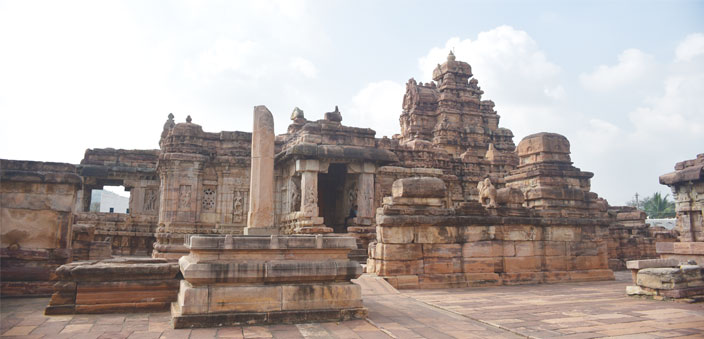
The VirupakshaTemple incorporates an entrance gateway, Nandi pavillion, porch, mandapa, an antechamber and the central garbhgriha. The temple is aligned like the others in an east-west axis. The walls and columns of the temple hold together a seemingly impossible array of compositions. Legends, myths, narratives, history and sublime art combine on what was once plain rock to celebrate and pay obeisance to the lord of the lords – the Mahadev – Lord Shiva. Quite satisfactorily, this temple and its Nandi mandapa are the only ones which are active, and draw as many devotees as art aficionados and in my opinion, both leave with some traces of the other.
A story ends…or does It?
While leaving, one realises all of a sudden that at some point, all of this must have also been painted. So many stories and yet experts opine that none of them were ever quite completed, pointing at (perhaps imagined) unfinished patches. If it were all to be completed, how much would there have been! Perhaps it is for the better. Perhaps there is a sensory threshold to beauty that must not be crossed and that is why this was left the way it is. Of course, history tells us otherwise. But that is boring. This is a much better story…
Or perhaps, the finishing touch is the visitor. The carrier of the story. Perhaps that is the last chisel stroke in an unending line of completeness that has been continuing for 1500 years. Each stroke of the clock, an imprint of stone on the glaze of individual memories. An eternal string of stories, only begun in stone, with human threads that will carry it far and wide. Each story will end differently. And that end will only be another beginning. This is where my story of the almond stones ends. This is where yours begins. Journey safe, now my friend. You too carry a tale in your womb. A tale you must tell. The taller the better.

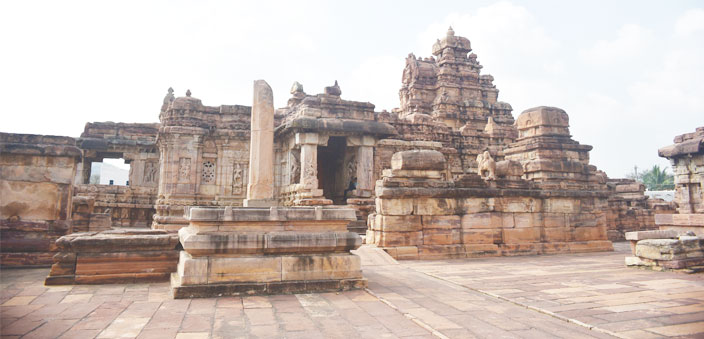
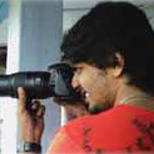 [/column]
[/column]